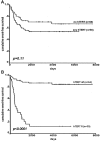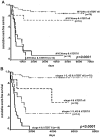Full-length telomerase reverse transcriptase messenger RNA is an independent prognostic factor in neuroblastoma
- PMID: 12598334
- PMCID: PMC1868090
- DOI: 10.1016/S0002-9440(10)63896-5
Full-length telomerase reverse transcriptase messenger RNA is an independent prognostic factor in neuroblastoma
Abstract
Telomerase activity (TA) is the most recently recognized prognostic factor in neuroblastoma, and its outstanding predictive power was documented by several studies. However, TA measurements require fresh tumor tissue that is not always available in daily clinical practice. We previously described a reverse transcriptase-polymerase chain reaction assay that we used to investigate the possible prognostic relevance of the telomerase catalytic subunit, hTERT, at the mRNA level. Because hTERT mRNA undergoes alternative splicing as a regulatory mechanism of TA, we discriminated between truncated and full-length hTERT transcripts. In a retrospective study on 124 neuroblastomas, 56 (45.2%) tumors showed spliced hTERT transcripts, whereas 30 (24.2%) contained full-length hTERT transcripts. The presence of both spliced and full-length hTERT transcripts was significantly associated with MYCN amplification. hTERT in general showed no correlation to other prognostic factors, ie, International Neuroblastoma Staging System stage, International Neuroblastoma Pathology classification grade, or age at diagnosis, whereas the presence of full-length transcripts was significantly associated with higher stages. The presence of any hTERT transcripts carried no significant prognostic information, yet full-length hTERT transcripts were highly predictive of poor outcome (P < 0.0001). In a multivariate analysis, full-length hTERT transcripts and International Neuroblastoma Pathology classification grade emerged as the sole independent predictors of event-free survival, with relative risks of 10.0 and 3.9, respectively. The strong statistical correlation of full-length hTERT transcripts with clinical outcome in neuroblastoma suggests that the reverse transcriptase-polymerase chain reaction analysis of hTERT transcripts may be equatable to TA measurements. Because this assay is well suited for archival material, it could become a useful adjunct in evaluating the prognosis of individual neuroblastoma cases.
Figures




Similar articles
-
Regulation of telomerase activity by alternate splicing of human telomerase reverse transcriptase mRNA in a subset of neuroblastomas.Am J Pathol. 2001 Nov;159(5):1925-32. doi: 10.1016/S0002-9440(10)63039-8. Am J Pathol. 2001. PMID: 11696453 Free PMC article.
-
Telomerase activity and telomerase subunits gene expression patterns in neuroblastoma: a molecular and immunohistochemical study establishing prognostic tools for fresh-frozen and paraffin-embedded tissues.J Clin Oncol. 2000 Jul;18(13):2582-92. doi: 10.1200/JCO.2000.18.13.2582. J Clin Oncol. 2000. PMID: 10893290
-
[Proliferation and hTERT expression in neuroblastoma].Pathologe. 2004 Jul;25(4):317-23. doi: 10.1007/s00292-004-0703-8. Pathologe. 2004. PMID: 15168079 German.
-
Cross-study analysis of gene expression data for intermediate neuroblastoma identifies two biological subtypes.BMC Cancer. 2007 May 25;7:89. doi: 10.1186/1471-2407-7-89. BMC Cancer. 2007. PMID: 17531100 Free PMC article. Review.
-
Biological categories of neuroblastoma based on the international neuroblastoma pathology classification for treatment stratification.Pathol Int. 2021 Apr;71(4):232-244. doi: 10.1111/pin.13085. Epub 2021 Mar 3. Pathol Int. 2021. PMID: 33657257 Review.
Cited by
-
Alternative splicing of human telomerase reverse transcriptase in gliomas and its modulation mediated by CX-5461.J Exp Clin Cancer Res. 2018 Apr 10;37(1):78. doi: 10.1186/s13046-018-0749-8. J Exp Clin Cancer Res. 2018. PMID: 29631594 Free PMC article.
-
G-quadruplexes as potential therapeutic targets for embryonal tumors.Molecules. 2013 Oct 10;18(10):12500-37. doi: 10.3390/molecules181012500. Molecules. 2013. PMID: 24152672 Free PMC article. Review.
-
Amplification of telomerase (hTERT) gene is a poor prognostic marker in non-small-cell lung cancer.Br J Cancer. 2006 May 22;94(10):1452-9. doi: 10.1038/sj.bjc.6603110. Br J Cancer. 2006. PMID: 16641908 Free PMC article.
-
Detection of GD2-positive cells in bone marrow samples and survival of patients with localised neuroblastoma.Br J Cancer. 2008 Jan 29;98(2):263-9. doi: 10.1038/sj.bjc.6604179. Epub 2008 Jan 8. Br J Cancer. 2008. PMID: 18182983 Free PMC article.
-
Alternative Splicing of hTERT Pre-mRNA: A Potential Strategy for the Regulation of Telomerase Activity.Int J Mol Sci. 2017 Mar 7;18(3):567. doi: 10.3390/ijms18030567. Int J Mol Sci. 2017. PMID: 28272339 Free PMC article. Review.
References
-
- Maris JM, Matthay KK: Molecular biology of neuroblastoma. J Clin Oncol 1999, 17:2264-2279 - PubMed
-
- Brodeur GM, Seeger RC, Schwab M, Varmus HE, Bishop JM: Amplification of N-myc in untreated human neuroblastomas correlates with advanced disease stage. Science 1984, 224:1121-1124 - PubMed
-
- Bown N, Cotterill S, Lastowska M, O’Neill S, Pearson AD, Plantaz D, Meddeb M, Danglot G, Brinkschmidt C, Christiansen H, Laureys G, Speleman F: Gain of chromosome arm 17q and adverse outcome in patients with neuroblastoma. N Engl J Med 1999, 340:1954-1961 - PubMed
-
- Brodeur GM, Maris JM, Yamashiro DJ, Hogarty MD, White PS: Biology and genetics of human neuroblastomas. J Pediatr Hematol Oncol 1997, 19:93-101 - PubMed
MeSH terms
Substances
LinkOut - more resources
Full Text Sources
Medical

